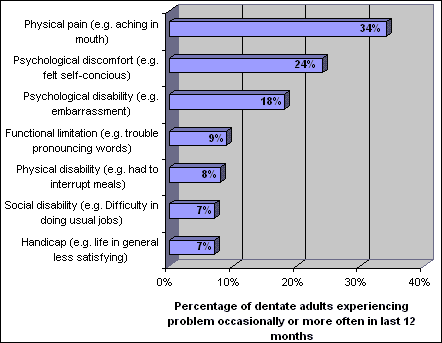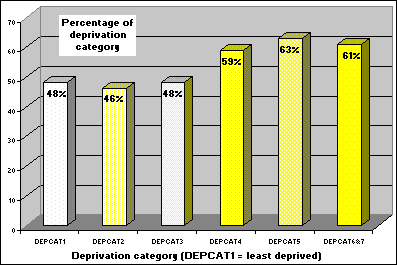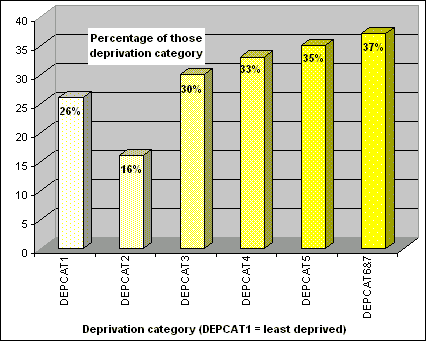Ths peer reviewed article was first published in the journal Tuith OnlineSelf-reported impact of dental disease among Scottish dentate adults(based on the 1998 Adult Dental Health Survey) by Nigel M. Nuttall, Dental Health Services Research Unit This article is part 2 of 4 of an invited article series. View parts 1, 3, and 4. This article examines the effect that oral health can have on people's lives. Knowledge of the extent of dental disease gives a clinical indication of the experience of dental problems but it does not necessarily reflect the problems that people experience as a result of their dentition. There are differences between clinicians' and the public's evaluation of oral health. For example, dentists often appear to be most concerned about the integrity of previous dental work whereas patients often seem most concerned with the appearance of their teeth. It is becoming increasingly appreciated that the way a disease affects people's lives is just as important as epidemiological measures of its prevalence or incidence. This is the first of the UK adult dental health surveys to use and report a measure of the self-perceived impact on people of the dental and periodontal diseases and other oral conditions. The impact of dental diseaseThere have been a variety of approaches to measuring the impact of dental disease (Slade, 1997a). This chapter considers people's perceptions of how they are affected as a whole by dental disease and conditions using the Oral Health Impact Profile (OHIP) developed by Slade (Slade, 1997b). The aim of this index is to provide a comprehensive measure of self-reported dysfunction, discomfort and disability arising from oral conditions. It is based on Locker's adaptation of the World Health Organisation's classification of impairments, disabilities and handicaps (Locker, 1988). In the WHO model, impacts are organised linearly to move from a biological to a behavioural to a social level of analysis. Slade and Spencer adapted this by proposing seven dimensions of impact of oral condition. Each of the 7 dimensions in the original scale was assessed from questions on the type of problems experienced (a total of 49 questions). A shortened version (OHIP-14) was later developed based on a subset of 2 questions for each of the 7 dimensions (Slade, 1997b). The dimensions and questions associated with them are:-
In figure 1 the impact of the seven dimensions which make up the OHIP index are arranged in the order according to how many people reported being affected by them. Over a third of the dentate population of Scotland reported being affected by oral pain occasionally or more often in the preceding 12 months. A quarter also reported that their oral condition had made them feel self conscious or tense. Just over a fifth (18%) found their oral condition made it difficult to relax or felt embarrassed by it. Fewer reported being affected functionally by their oral condition; 9% said they had had some trouble pronouncing words or that their sense of taste had changed and 8% felt that their diet had been unsatisfactory or that they had had to interrupt meals because of their oral condition. Figure 1. Reported impact of health in previous 12 months among dentate adults in Scotland in 1998 assessed by the Oral Health Impact Profile (OHIP14) 
Although some impacts were not reported very frequently they were nevertheless important as they concern people whose dental condition is such that it affects their life. Almost 1 in 12 dentate adults in Scotland reported that their oral condition had an occasional impact on their quality of life as a whole over the preceding 12 months. For 8% of people this was reflected in making their life in general less satisfying on occasion but in the case of a small percentage of people it amounted to feeling totally unable to function on occasion as a result of their oral condition. Impact of oral disease and deprivationPrevious articles in this series have shown how material deprivation indicated by factors such as lower car ownership and male unemployment is associated with people who are more likely to have lost all their natural teeth or to have poorer dental health than those who live in more affluent areas. The OHIP analysis has shown that this also translates to a poorer experience of oral health. Over 60% of those in the most deprived areas reported occasional experience of an OHIP-14 problem at some time during the previous year in comparison with under 50% of those from better-off areas (Figure 2). Figure 2. Experience of an OHIP14 problem occasionally or more often in the previous 12 months by deprivation category among dentate adults in Scotland in 1998 
Another aspect of oral condition which these surveys have shown is important to people is the appearance of teeth. Appearance seems to be a more important factor than tooth function as it has been shown that people are more willing to have back teeth removed than front teeth. Furthermore many people are dissatisfied with the appearance of their teeth. Figure 3 shows that those who live in the most deprived areas have a poorer perception of the appearance of their own teeth than those who live in the most affluent areas; over a third of those living in areas experiencing most deprivation were dissatisfied with the appearance of their teeth in comparison with just over a quarter of those in the most affluent areas. Figure 3. Dissatisfaction of teeth by deprivation category among dentate adults in Scotland 1972-1998 
Thanks and DisclaimersThe DHSRU would like to thank all the dentists and interviewers who often worked unsocial hours to undertake the dental examinations and people who gave their time to be interviewed and dentally examined. This work was undertaken by a consortium comprising the Office for National Statistics and the Dental Schools of the Universities of Birmingham, Dundee, Newcastle and Wales who received funding from the United Kingdom Health Departments; the views expressed in this publication are those of the author and not necessarily those of the Health Departments nor of the other members of the consortium. Nigel Nuttall acknowledges support from the Chief Scientist Office of the Scottish Executive who do not necessarily share the views expressed. ReferencesKelly, M., Steele, J., Nuttall, N., Bradnock, G., Morris, J., Nunn, J., Pine, C., Pitts, N., Treasure, E., and White, D. (2000) Adult Dental Health Survey - Oral Health in the United Kingdom 1998. London: The Stationery Office. Slade, G. (ed). (1997a) Measuring oral health and quality of life Chapel Hill: University of North Carolina, Dental Ecology. Slade, G.D. (1997b) Derivation and validation of a short-form oral health impact profile. Community Dentistry Oral Epidemiology 25: 284-290. Locker, D. (1998) Measuring oral health: a conceptual framework. Community Dental health 5: 5-13. |
||||||||||||||||
|
Web space provided by the University of Dundee,
maintained by
the Dental Health Services Research Unit. Valid XHTML1.0
|
 |
Evidence-based dentistry web-site | |